
Getting from Narita Airport to Myoko Kogen
Route Map
There are many different routes for getting from Narita Airport to Myoko Kogen. If it is your first time to Myoko Kogen, or you have a lot of luggage, then you may be better off using a direct service like the Nagano Snow Shuttle.
Below we summarize the easiest route to Myoko Kogen from Narita Airport by Public Transport. If you’d like advice on other routes, please do not hesitate to send us an inquiry. Or fill in the form on the right.
Narita Airport
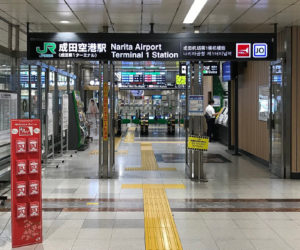 There are 2 train lines between Narita Airport and and Central Tokyo. The Narita Express, and the Keisei Skyliner. The Narita Express runs from Terminal 1, via terminal 2 to JR Tokyo Station. The Keisei Skyliner runs from Terminal 1 via Terminal 2 to Keisei Ueno Station, close to JR Ueno Station Tokyo.
There are 2 train lines between Narita Airport and and Central Tokyo. The Narita Express, and the Keisei Skyliner. The Narita Express runs from Terminal 1, via terminal 2 to JR Tokyo Station. The Keisei Skyliner runs from Terminal 1 via Terminal 2 to Keisei Ueno Station, close to JR Ueno Station Tokyo.
The JR transfer is easier as you can buy all your tickets at Narita Airport, but the Keisei Line is actually a bit quicker.
Below we cover the transfer using the JR Narita Express and JR Hokuriku Shinkansen Bullet Train.
Terminal 1 (Narita Kuko Station)
The JR station is located in the basement of Terminal 1. The station is called “Narita Kuko” but the there are many English and Chinese signs that identify it as Terminal 1.
Terminal 2 (Kuko Daini Biru)
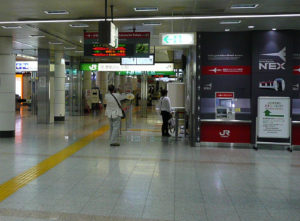 Narita Airport Terminal 2 Station
Narita Airport Terminal 2 Station
The JR station is located in the basement of Terminal 2. The station is called “Narita Daini Biru” but the there are many English and Chinese signs that identify it as Terminal 2.
Terminal 3
There are not stations at terminal 3. The closest station is terminal 2. It is about 400m from terminal 3 to terminal 2. There is a well sign posted walkway (15 min walk), or you can take the free shuttle from terminal 3 to terminal 2 in about 3 minutes. The shuttle bus stop does not have a number but is easy to find if you take the escalator down to the bus top floor.
Buying a Ticket
All the JR ticket counters are red. You can buy a ticket from a machine, but most international visitors will find it easiest to go to the JR EAST Travel Service Center. These are set up for foreign visitors and staff speak English. Explain that you want to go to Nagano, and they will work out the next available times and transfers and issue your tickets.
Hint: Try to get a seat in car number 6 or above on the Bullet train to Nagano, as this will make it much easier to transfer at Nagano Station to the bus to Hakuba
Boarding the Train
The train tracks are on the level below the tickets sales and ticket gates. You will have several tickets in your hand, just put them all into the ticket machine together (not one at a time), and they will reappear part way down the ticket gate. Make sure you take your all your tickets.
Take the escalator down and locate your car number. Trains run on time so be on board with time to spare.
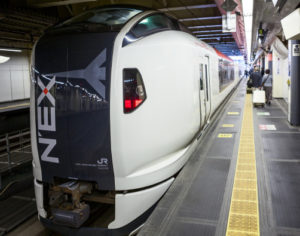
JR Narita Express
JR Narita Express is the flagship airport express train for JR East. It is a modern train with charging points in all seats and free Wifi on-board.
It usually operates as a 12 carriage train (actually 2 * 6 carriage trains that split at Tokyo Station).
Cars 1-5, and 7-11 are standard cars, while car 6 & 12 are Green Class (first class).
There is wheel chair access in cars 5 & 11
Car 1 is the front of the train when departing from Narita Airport.
All cars have 4 seats across, with an aisle in the middle.
Almost all Narita Express Trains head directly to Tokyo Station with no stops in between, but there is the occasional train that makes a brief stop at Chiba Sation.
The trip from Narita Airport to Tokyo Station takes about 1 hour.
Tokyo Station is massive, and is the 3rd busiest station in Japanese with nearly 500,000 people daily.
On the main concourse level there are 10 platforms for commuter and express trains, and 10 platforms for Shinkansen Bullet trains.
There are also basement platforms (4) and a further 2 platforms for the JR Keio Line. Add in a couple of subway stations and you get the picture.
Rush hour here can be mayhem!
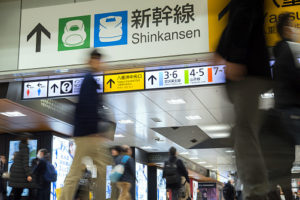
On arrival at Tokyo Station you will on basement level 5 (You arrive at Sobu Line platform 1 or 2). You need to get to the Hokuriku Shinkansen Bullet Train Platforms 20-23.
You need to go up several sets of elevators and follow the signs (the green ones as pictured on right) to the Shinkansen Bullet train platforms.
The Shinkansen have an extra set of ticket gates. You need to put your tickets into the machine before you can pass through (always remember to collect your tickets as they pop out part way through the gate).
Once through the gates you’ll see a lot of digital signs that flick between English and Japanese. They will show the Train Name, Departure Time and Platform Number. Locate your platform and take the escalator up.
Hokuriku Shinkansen via Nagano
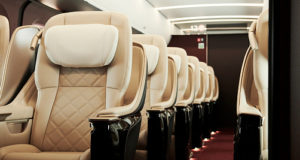
Train Classes
There are several classes on the Hokuriku Shinkansen.
- Standard Class (reserved and non reserved*) – 5 seats across the row in a 3-2 configuration (Cars 1-10)
- Green Class (superior class) – 4 seats across the row in a 2-2 configuration (Car 11) – Green Class costs about 20% more than standard class
- Gran Class (first class) – 3 seats across the row in a 1-2 configuration (Car 12). Complementary food and beverage service (Kagayaki and Hakutaka trains only) – Gran Class costs about double of standard class
- reserved seat means you have an assigned seat / non-reserved means you can sit in any seat in a “non-reserved” carriage (first come first seated basis)
Train Types
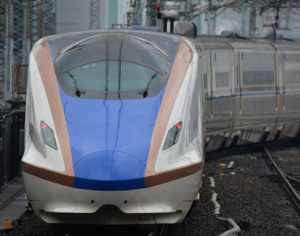
There are 3 types of train that run on the Hokuriku Shinkansen Line. While the train body is the same, the speed and number of stops vary. All trains will have either Kanazawa or Nagano as the destination, but all trains do make a stop in Nagano.
In all cases there are 12 carriages on the train with 12 being the front of the train heading towards Nagano.
- “Kagayaki” – This is the fastest type of train. After departing Tokyo it only stops at Ueno, and Omiya before arriving at Nagano. All seats on this train are reserved (seat assigned). The destination for the Kagayaki trains is Kanazawa. From Tokyo Station to Nagano this train takes about 90 minutes.
- “Hakutaka” – This train also heads to Kanazawa, but it stops at more stations along the way and is about 15 minutes slower than the Kagayaki Train. There are reserved and non-reserved seats on this train.
- Asama – This train only travels as far as Nagano, but it stops at most stations along the way.
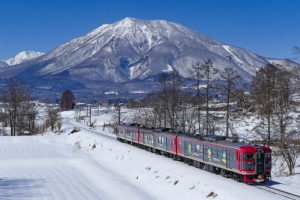
Shinano Rail Co
The company operating the line between Nagano Station and Myoko Kogen is called “Shinano Tetsudo”, or Shina Rail Co.
There is only about 1 train per hour from Nagano Station to Myoko Kogen. These are commute trains that stop at every station. The trip from Nagano to Myoko Kogen takes about 45 minutes.
Buying a Ticket
As the Shinano Co is not a JR Line, your original ticket does not cover this part of the trip. However you can pay for your ticket when you arrive in Myoko Kogen. (Make sure you keep you JR tickets to show that you boarded the train in Nagano).
Boarding the Train
On arrival in Nagano, you need to transfer from the Shinkansen Bullet train line to the Shinano Rail Co Line. There are a set of transfer gates on the main concourse level. You pass through the gates (collect your tickets) and head down a small escalator. Use the digital signage to locate the next train to Myoko Kogen, and head to that platform a few minutes before departure.
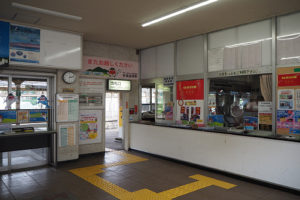
Arrival in Myoko Kogen
Trains from Nagano generally arrive at platform 2. This is a hassle as you need to climb stairs, cross the bridge, go down the stairs, and to the exit (all while carrying your luggage).
At the exit, show your JR tickets to the staff member and he/she will charge you 850yen for the trip from Nagano. Cash only.
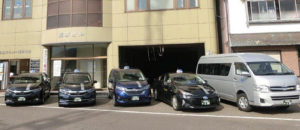
Myoko Kogen Station is located about 10 minutes drive from the ski resort areas.
Unless your accommodation offers a pick up from the station, taxi is the best option for getting from that station to your accommodation.
There are often taxis parked in front of the station (especially when trains arrive). Kogen Taxi is located in the large building across the road from the station to the south. You may be able to walk in there and order a taxi (but they do not have English speaking staff)
